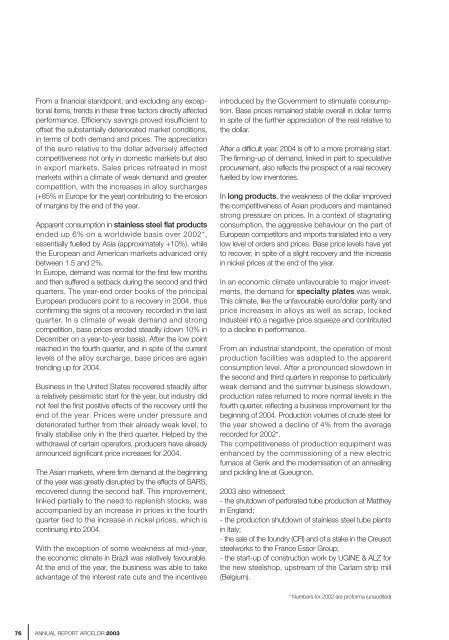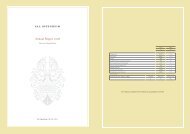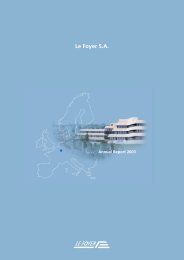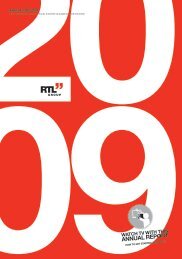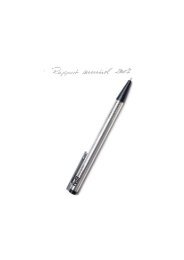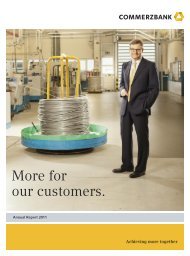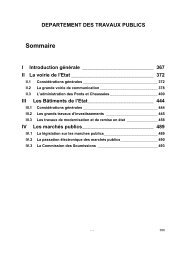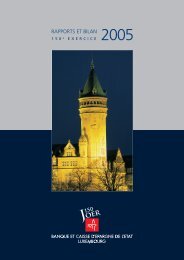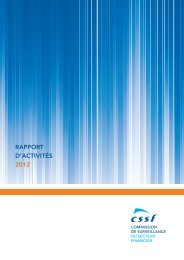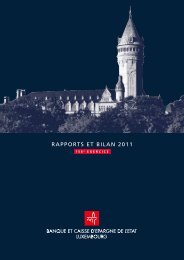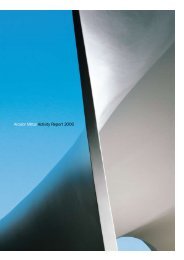ANNUAL REPORT ARCELOR 2003 - paperJam
ANNUAL REPORT ARCELOR 2003 - paperJam
ANNUAL REPORT ARCELOR 2003 - paperJam
Create successful ePaper yourself
Turn your PDF publications into a flip-book with our unique Google optimized e-Paper software.
From a financial standpoint, and excluding any exceptionalitems, trends in these three factors directly affectedperformance. Efficiency savings proved insufficient tooffset the substantially deteriorated market conditions,in terms of both demand and prices. The appreciationof the euro relative to the dollar adversely affectedcompetitiveness not only in domestic markets but alsoin export markets. Sales prices retreated in mostmarkets within a climate of weak demand and greatercompetition, with the increases in alloy surcharges(+85% in Europe for the year) contributing to the erosionof margins by the end of the year.Apparent consumption in stainless steel flat productsended up 6% on a worldwide basis over 2002*,essentially fuelled by Asia (approximately +10%), whilethe European and American markets advanced onlybetween 1.5 and 2%.In Europe, demand was normal for the first few monthsand then suffered a setback during the second and thirdquarters. The year-end order books of the principalEuropean producers point to a recovery in 2004, thusconfirming the signs of a recovery recorded in the lastquarter. In a climate of weak demand and strongcompetition, base prices eroded steadily (down 10% inDecember on a year-to-year basis). After the low pointreached in the fourth quarter, and in spite of the currentlevels of the alloy surcharge, base prices are againtrending up for 2004.Business in the United States recovered steadily aftera relatively pessimistic start for the year, but industry didnot feel the first positive effects of the recovery until theend of the year. Prices were under pressure anddeteriorated further from their already weak level, tofinally stabilise only in the third quarter. Helped by thewithdrawal of certain operators, producers have alreadyannounced significant price increases for 2004.The Asian markets, where firm demand at the beginningof the year was greatly disrupted by the effects of SARS,recovered during the second half. This improvement,linked partially to the need to replenish stocks, wasaccompanied by an increase in prices in the fourthquarter tied to the increase in nickel prices, which iscontinuing into 2004.With the exception of some weakness at mid-year,the economic climate in Brazil was relatively favourable.At the end of the year, the business was able to takeadvantage of the interest rate cuts and the incentivesintroduced by the Government to stimulate consumption.Base prices remained stable overall in dollar termsin spite of the further appreciation of the real relative tothe dollar.After a difficult year, 2004 is off to a more promising start.The firming-up of demand, linked in part to speculativeprocurement, also reflects the prospect of a real recoveryfuelled by low inventories.In long products, the weakness of the dollar improvedthe competitiveness of Asian producers and maintainedstrong pressure on prices. In a context of stagnatingconsumption, the aggressive behaviour on the part ofEuropean competitors and imports translated into a verylow level of orders and prices. Base price levels have yetto recover, in spite of a slight recovery and the increasein nickel prices at the end of the year.In an economic climate unfavourable to major investments,the demand for specialty plates was weak.This climate, like the unfavourable euro/dollar parity andprice increases in alloys as well as scrap, lockedIndusteel into a negative price squeeze and contributedto a decline in performance.From an industrial standpoint, the operation of mostproduction facilities was adapted to the apparentconsumption level. After a pronounced slowdown inthe second and third quarters in response to particularlyweak demand and the summer business slowdown,production rates returned to more normal levels in thefourth quarter, reflecting a business improvement for thebeginning of 2004. Production volumes of crude steel forthe year showed a decline of 4% from the averagerecorded for 2002*.The competitiveness of production equipment wasenhanced by the commissioning of a new electricfurnace at Genk and the modernisation of an annealingand pickling line at Gueugnon.<strong>2003</strong> also witnessed:- the shutdown of perforated tube production at Mattheyin England;- the production shutdown of stainless steel tube plantsin Italy;- the sale of the foundry (CFI) and of a stake in the Creusotsteelworks to the France Essor Group;- the start-up of construction work by UGINE & ALZ forthe new steelshop, upstream of the Carlam strip mill(Belgium).* Numbers for 2002 are proforma (unaudited)76<strong>ANNUAL</strong> <strong>REPORT</strong> <strong>ARCELOR</strong> <strong>2003</strong>


